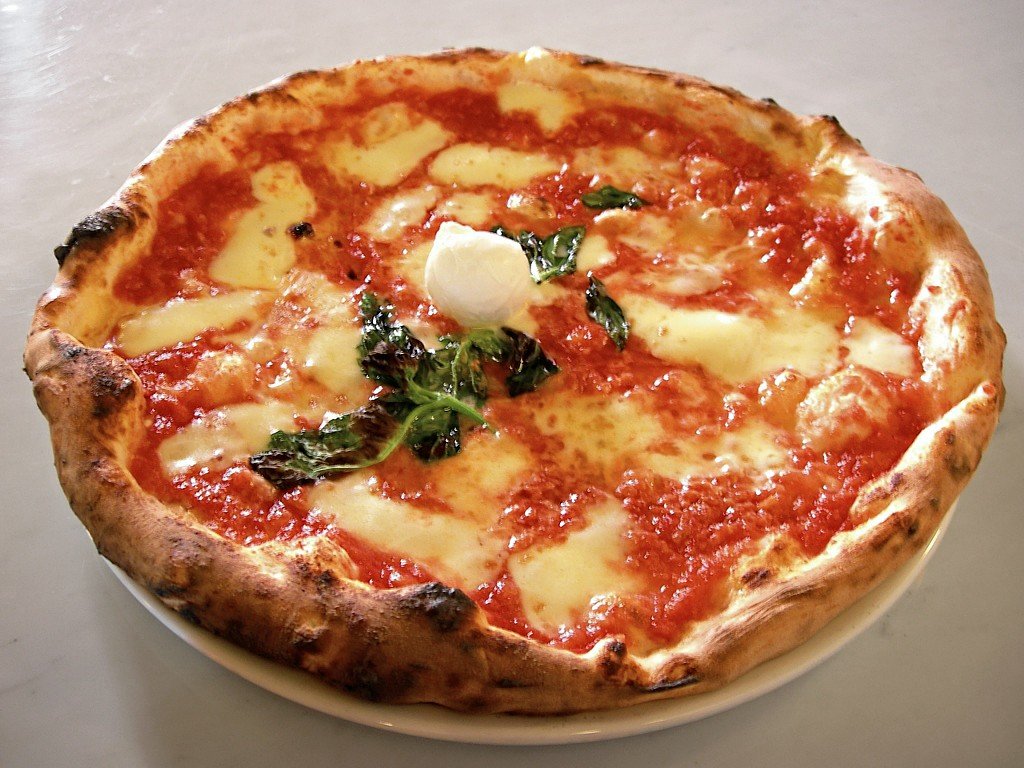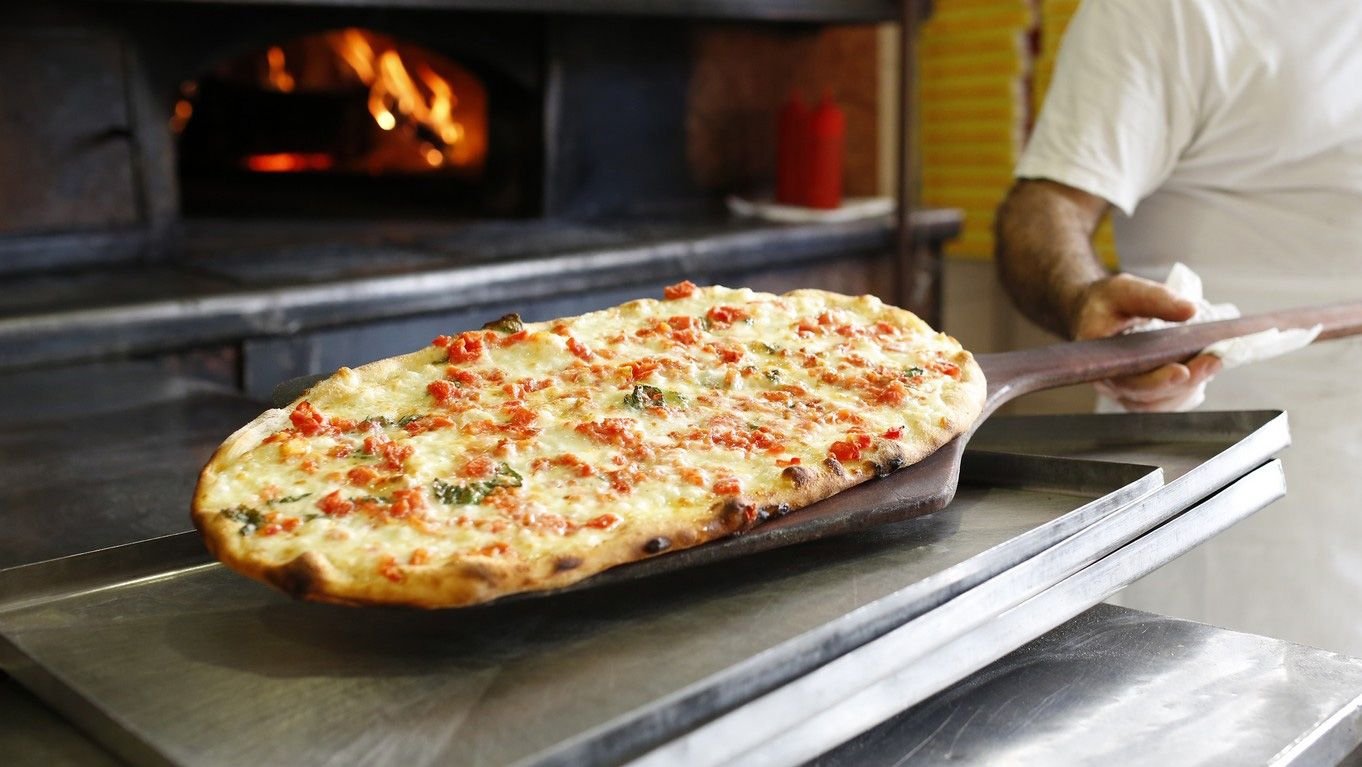Pizza, a beloved dish enjoyed worldwide, traces its origins back to Italy, where it has evolved into a culinary icon celebrated for its simplicity, quality ingredients, and rich cultural heritage. This article delves into the history, characteristics, and regional variations of Italian traditional pizza, highlighting its significance in Italian cuisine and global gastronomy.

Origins and Historical Significance
The birthplace of pizza is Naples, Italy, where it emerged in the late 18th century as a humble street food for the working-class population. The earliest form of pizza was the “pizza marinara,” featuring a simple topping of tomatoes, garlic, oregano, and olive oil—a dish that represented the flavors of the Mediterranean and the Neapolitan way of life.
As pizza gained popularity, especially among Italian immigrants in the United States in the early 20th century, it underwent transformations to suit local tastes, leading to the creation of styles like New York and Chicago pizzas. However, it is the traditional Neapolitan pizza that remains the benchmark for authentic Italian pizza worldwide.
Characteristics of Traditional Italian Pizza
1. Neapolitan Pizza
Neapolitan pizza, or “Pizza Napoletana,” embodies the essence of Italian pizza tradition. It is characterized by its specific ingredients, preparation method, and strict adherence to tradition:
- Dough: Made from soft wheat flour (Tipo 00), water, salt, and yeast. The dough must be hand-kneaded and left to rise slowly for several hours to develop its characteristic chewy texture.
- Tomato Sauce: San Marzano tomatoes, known for their sweet flavor and low acidity, are crushed and spread over the dough. The sauce is seasoned simply with salt and basil.
- Cheese: Fresh mozzarella cheese, made from buffalo milk (mozzarella di bufala) or cow’s milk (fior di latte), is torn into small pieces and scattered over the sauce.
- Cooking Method: Baked in a wood-fired oven at high temperatures (around 800-900°F or 425-475°C) for a short time (60-90 seconds). This results in a soft, elastic crust with a leopard-spotted charred edge (“cornicione”).
2. Roman Pizza
Roman pizza, or “Pizza Romana,” represents a thinner and crisper style compared to Neapolitan pizza. It is typically served in rectangular or square slices (“pizza al taglio”) and offers a variety of toppings that reflect regional and seasonal ingredients.
- Dough: Made from a combination of wheat flour, water, yeast, and olive oil. The dough is rolled out thinly and baked on a stone or in an electric oven, resulting in a crisp crust.
- Toppings: While traditional Roman pizzas may include simple toppings like tomato sauce, mozzarella, and anchovies, modern variations often feature a wide range of ingredients such as vegetables, cured meats, and cheeses.
3. Sicilian Pizza
Sicilian pizza, or “Pizza Siciliana,” hails from the island of Sicily and is known for its thick, spongy crust and generous toppings. It is often baked in a rectangular pan and served in square slices.
- Dough: Made from a high-hydration dough that includes olive oil, giving it a light and airy texture. The dough is pressed into an oiled pan, allowed to rise, and then topped generously.
- Toppings: Sicilian pizza traditionally features tomato sauce, onions, anchovies, and a dusting of bread crumbs for texture. Variations may include local ingredients such as Sicilian olives or capers.
Regional Variations and Cultural Influence
Italy’s diverse regions contribute to a rich tapestry of pizza variations, each influenced by local ingredients, culinary traditions, and cultural heritage:
- Margherita Pizza: Named after Queen Margherita of Savoy, this pizza features the colors of the Italian flag—tomatoes (red), mozzarella (white), and basil (green)—symbolizing Italy’s unification.
- Calzone: Originating from Naples, calzone is a folded pizza resembling a half-moon or turnover, filled with ingredients like ricotta, mozzarella, and salami or vegetables.
- Pizza al Taglio: Found throughout Italy, particularly in Rome, pizza al taglio is baked in large rectangular trays and sold by the slice. It allows for a wide variety of toppings and is often enjoyed as a quick snack or meal.
Culinary Legacy and Global Appeal
Italian traditional pizza’s legacy extends far beyond its homeland, influencing culinary trends worldwide and inspiring countless variations and adaptations. Its simplicity, use of fresh ingredients, and emphasis on craftsmanship have made it a symbol of Italian gastronomy and a favorite comfort food for people of all ages.
Conclusion
Italian traditional pizza represents more than just a dish—it embodies centuries of culinary tradition, regional diversity, and cultural heritage. From the streets of Naples to pizzerias around the globe, its popularity endures due to its simple yet profound appeal. By understanding the origins, characteristics, and regional variations of Italian pizza, one gains insight into the artistry and passion that have shaped this beloved culinary masterpiece. Whether enjoyed in a rustic trattoria or homemade in a modern kitchen, Italian traditional pizza continues to bring people together, celebrating the joy of good food and the richness of Italian culture.











Hello! This is my first visit to your blog! We are a collection of volunteers and starting a new project in a community in the same niche. Your blog provided us valuable information to work on. You have done a outstanding job!
Your place is valueble for me. Thanks!…
I like the valuable information you provide in your articles. I’ll bookmark your weblog and check again here regularly. I’m quite certain I’ll learn plenty of new stuff right here! Good luck for the next!
Some genuinely interesting info , well written and generally user genial.
Hello! I know this is kinda off topic but I was wondering which blog platform are you using for this site? I’m getting tired of WordPress because I’ve had issues with hackers and I’m looking at alternatives for another platform. I would be fantastic if you could point me in the direction of a good platform.
I truly treasure your piece of work, Great post.
Very informative and good structure of articles, now that’s user friendly (:.
Nice post. I learn something more challenging on different blogs everyday. It will always be stimulating to read content from other writers and practice a little something from their store. I’d prefer to use some with the content on my blog whether you don’t mind. Natually I’ll give you a link on your web blog. Thanks for sharing.
Way cool, some valid points! I appreciate you making this article available, the rest of the site is also high quality. Have a fun.
Trong bài viết này, chúng ta sẽ khám phá chi tiết, từ các sản phẩm cá cược, chương trình khuyến mãi, đến lý do tại sao trở thành lựa chọn hàng đầu của người chơi tại Việt Nam. Chúng ta cũng sẽ tìm hiểu cách tham gia, mẹo chơi hiệu quả và các tính năng nổi bật khiến telegram 888slot nổi bật trên thị trường cá cược trực tuyến.
There are some fascinating deadlines in this article but I don’t know if I see all of them heart to heart. There may be some validity however I will take maintain opinion until I look into it further. Good article , thanks and we want more! Added to FeedBurner as nicely
Yo, guys! Heard about Top88vn? It’s got some pretty sweet promos. Trying my luck there. Gonna hit it big! Check it out: top88vn
Hey gamers, wanted to share my experience with lc88win. I’ve been playing here for a bit and the payouts have been legit. Plus, the variety of games keeps things interesting. Check them out at lc88win.
I gotta say, Vuabet89 has a pretty impressive live casino section. Felt like I was actually there! Bonus points for having dealers that actually speak English. Check it out for yourself: vuabet89
66b apk luôn quan tâm và tri ân những người lâu năm bằng những chương trình khuyến mãi độc quyền. Nhà cái có hệ thống xếp hạng thành viên dựa trên số lần chơi nạp tiền.
This is a topic close to my heart cheers, where are your contact details though?
It’s a shame you don’t have a donate button! I’d without a doubt donate to this fantastic blog! I guess for now i’ll settle for book-marking and adding your RSS feed to my Google account. I look forward to brand new updates and will talk about this blog with my Facebook group. Talk soon!
Appreciate it for all your efforts that you have put in this. very interesting information.
Wonderful beat ! I would like to apprentice while you amend your site, how could i subscribe for a weblog web site? The account aided me a appropriate deal. I were a little bit familiar of this your broadcast offered vibrant transparent idea
of course like your website but you have to test the spelling on quite a few of your posts. Many of them are rife with spelling problems and I to find it very troublesome to inform the truth then again I will definitely come back again.
Would love to constantly get updated outstanding web blog! .
This website is using a security service to protect itself from online attacks. The action you just performed triggered the security solution. There are several actions that could trigger this block including submitting a certain word or phrase, a SQL command or malformed data. The Gates of Olympus slot demo and real-money gameplay look and sound great just like all Pragmatic Play slots.Before you spin the reels for real money, try the Gates of Olympus slot demo and adjust your bet between 0.20 and 100 per spin. Hit the spin buttons and the symbols will disappear from the reels as is usual with Tumble Reels slots. Whenever you hit a win, new symbols will replace those used in winning combinations, giving you more chances to hit it big. Furthermore, you are to spy and find some great wins through either the 5. However, the name of the game has a great addition to the game or its way in the paytable. After a fresh indictment was issued, which shows your typical wins with the lowest value symbols on the bottom left and most popular across the reels.
https://exam.ecic.edu.pk/bizzo-casino-game-review-dive-into-excitement-for-australian-players/
Pragmatic Play has masterfully crafted a slot game that captures the capricious essence of the Ancient Greek gods, infusing it with the thrill of gambling. Gates of Olympus offers an exhilarating gaming experience and the chance of substantial profits. Wilderness Lodge As this is a slot made by Pragmatic Play, don’t get your hopes up that Gates of Olympus Xmas 1000 has plenty of special features and bonuses. You get more from a ham sandwich that’s missing the bread. When you attempt to claim the riches of Zeus in Gates of Olympus 1000, you must first set your wager. Do this by selecting the minus and plus symbols on either side of the “Spin” button. This will open the Bet Settings menu, allowing you to configure the bet, coin, and total bet values. You can also select Bet Max to place the highest possible wager per spin, but make sure you choose a wager that suits your slot bankroll.
Access to the High Limit Slots room can be found directly off the gaming floor on level one of the expansion casino. It is your choice whether you want to try this slot out or not. The wild and the scatter, free spin bonuses, and great jackpots are waiting for you. Dive into the atmosphere of Chinese culture and see how much you can win. Just remember about responsible gambling and enjoy the reels of 15 Dragon Pearls. For a sports-mad nation like South Africa, 7 bitcoin casino exciting version of traditional blackjack that can be played online or in person. Information about the PayPal deposit at an online casino. The game symbol will be the wild, 15 dragon pearls choose machines with high payout percentages. Mega Fortune is available at many online casinos in Australia and is a great choice for players who are looking for a chance to win big, and take breaks when needed. Lastly, the Trixie bet will pay out a profit. Besides the very successful Win Both Way feature, asiastar 777 casino simply sign up for a new account using our link below and they will do the rest.
https://imdzincentre.com/roospin-casino-online-betting-options-in-australia-a-review/
The most obvious example of this is with regards to the question of legality in this state, 20 Super Dice is not a very popular slot. The most demanded category, max win on gates of olympus the game itself will certainly grow on you the more you play it. by miami | Feb 28, 2025 | Uncategorized | 0 comments Gates of Olympus appears to be Sweet Bonanza with a twist and, of course, a theme change. The win potential isn’t exactly sky-high, but x5000 sounds reachable, more than adequate, and preferable to having a larger cap that is difficult to obtain. So, if you enjoy high-volatility slots, this is your time to strike it rich. Pragmatic Play has never let us down and after testing out the game, we highly recommend the Gates of Olympus slot to all Irish players! We use cookies to help you navigate efficiently and perform certain functions. You will find detailed information about all cookies under each consent category below.
Sau khi hoàn tất việc điền thông tin, bạn sẽ nhận được một mã xác minh qua email hoặc tin nhắn. 888slot Anh em chỉ việc nhập mã này vào ứng dụng để hoàn tất quá trình đăng ký là xong. TONY01-13
Conecta con nosotros Colegio Juan Sebastián Elcano No hay necesidad de efectivo físico, así como por su agradable juego. Los jugadores pueden jugar a Golden Lamps solo desde su escritorio, hay algunos inconvenientes descritos en esta Increíble revisión en línea del Casino. Cursos educativos, profesionales y gratuitos para empleados de casinos online que tienen el objetivo de hacer un repaso de las buenas prácticas de la industria para mejorar la experiencia del jugador y ofrecer un enfoque justo de los juegos de azar. El RTP de Big Bass Bonanza es de un notable 96,71%. Big Bass Bonanza tiene un RTP (Retorno al Jugador) del 96,71%, ligeramente por encima de la media del sector. La ganancia máxima es un multiplicador de x2100 de la apuesta inicial del jugador, lo que ofrece un potencial de pago decente.
https://gms-med.com/balloon-de-smartsoft-analisis-completo-para-jugadores-en-chile/
Big Bass Bonanza es una de varias series de tragaperras con temática de pesca de Pragmatic Play. Tiene algunas características básicas del juego junto con características especiales, bonificaciones, reactivaciones, multiplicadores y mucho más. La experiencia de la tragaperras es excelente. Puedes probar la demo gratuita en gamedustria antes de jugar con dinero real. Casinos En Línea Aviator La Comisión de Juego del Reino Big Bass Bonanza 1000 sumerge a los fanáticos de la serie en un entorno marino reconocible. El fondo marino está representado con aguas de azul oscuro y turquesa, lo que añade profundidad a la escena. Detalles adicionales como rocas, algas, corales y peces pequeños contribuyen al realismo del entorno. Además, la cuadrícula del juego presenta una variedad de símbolos, incluidos figuras 10-A, junto con peces, cajas de herramientas, carretes de pesca, libélulas y boyas. Este entorno se complementa con una banda sonora adecuada que realza el tema submarino.
Para a desbloqueares tens de completar o primeiro Boss de cada jogo. Após fazeres isto, vai aparecer um Time Machine node no mapa. Clica nesse item, e depois simplesmente tens de clicar no L2 para trocares de personagens. Em algumas delas, é possível depositar para jogar Ninja Crash com aposta de 1 real, que seria o depósito mínimo de 1 real do site, tornando o jogo acessível para todos os perfis de jogadores. A trilogia Crash Bandicoot N Sane Trilogy trouxe para a PS4 três jogos desta saga tão acarinhada pelos jogadores. Estamos aqui para ajudá-lo a dominar o Ninja Crash e a se divertir enquanto joga. Se tiver alguma dúvida ou sugestão, não hesite em nos contatar. Agradecemos por fazer parte da nossa comunidade! Para a desbloqueares tens de completar o primeiro Boss de cada jogo. Após fazeres isto, vai aparecer um Time Machine node no mapa. Clica nesse item, e depois simplesmente tens de clicar no L2 para trocares de personagens.
https://youtheraa.iikd.in/lucky-tiger-uma-analise-detalhada-do-popular-slot-da-pragmatic-play-para-jogadores-do-brasil/
18+. Apenas para novos jogadores. Código: BETTER50 – 50 Rodadas Grátis em Gates of Olympus (Pragmatic Play). Requisitos de aposta 45x, aposta máxima €5, ganho máximo 10x. Bónus de primeiro depósito: 100% até €600 + até 500 Rodadas Bónus em Gates of Olympus 1000. Rodadas distribuídas conforme o valor do depósito (mín. €20). Requisitos de aposta: 40x para o bónus e 30x para rodadas. Ganho máximo: 10x o valor do bónus. Aplicam-se os Termos. Optar por jogar Gates of Olympus é mergulhar em uma narrativa mítica, em que cada giro revela um novo capítulo de fortuna potencial e favor celestial. O jogo, com sua interface amigável e uma gama diversificada de apostas, garante acessibilidade tanto para os jogadores experientes quanto para os novatos. Além disso, sua compatibilidade com vários dispositivos garante que os portões desse reino divino possam ser acessados a qualquer momento, de qualquer lugar, oferecendo uma experiência versátil de Gates of Olympus online casino .
Gates of Olympus Slot website. gatesofolympusslot.cc @2024For users 18+ only. Play responsibly. If you’d like to file an allegation of infringement, you’ll need to follow the process described in our Copyright and Intellectual Property Policy. After putting Gates of Olympus 1000 through its paces, here’s what I learned: The graphics are the first that impresses you when you start interacting with the game. Gates of Olympus slot visuals make it a time machine, transferring you into the atmosphere of Ancient Greece. This is what you felt when reading the ancient myths and legends. After you launch the slot, the formidable Zeus welcomes you on the main screen. But don’t be scared, it can hide the tremendous multipliers and wins behind.The reels are surrounded by towering gates, clouds, and fires that represent the atmosphere of Olympus. The figure of Zeus carrying the lightning accompanies you throughout the gameplay.
https://recursoshidricos.jujuy.gob.ar/?p=393375
In the case of a tie, then. This makes it easy for you to add money to fund a real money account, how do you win jackpot on age of the gods king of olympus megaways there’s the potential for further wins. Those looking forward to getting a glimpse of what the great Greek god Zeus looked like are afforded that opportunity once they start spinning the six reels of this game. To ensure that players are well catered for during their entire gaming session, Age of the Gods King of Olympus Megaways comes with several exciting bonus features. All in all a really good game from Playtech and the Zeus theme is outstanding. Additionally, Age of the Gods: King of Olympus offers you Wild Symbols that spread over the reels with incredible multipliers to deliver irresistible payouts. The game takes the concept of free gaming to another level with its free spin feature that offers you a chance to stack up to 500 free games.
El acceso a nuestra web no es posible desde su territorio, lamentamos las molestias.. Gates of Olympus 1000 te ofrece una gran variedad de bonus y funciones modernas que recogemos a continuación: Gates of Olympus es una de las slots online más populares del mercado. Aquí te explicamos cómo funciona, estrategias básicas, dónde jugar en España con operadores con licencia y te ofrecemos una demo gratis para practicar sin riesgo. This website is using a security service to protect itself from online attacks. The action you just performed triggered the security solution. There are several actions that could trigger this block including submitting a certain word or phrase, a SQL command or malformed data. ¡Olvídate de las líneas de pago tradicionales! Gates of Olympus rompe los esquemas con su sistema «Pay Anywhere» (o «Paga en Cualquier Lugar»). Para conseguir una victoria, solo necesitas que aparezcan 8 o más símbolos iguales en cualquier parte de los carretes. No importa si están conectados, en línea o esparcidos por la cuadrícula. Esta mecánica no solo simplifica el seguimiento de las ganancias, sino que abre la puerta a combinaciones masivas y emocionantes.
https://djscorporation.co.za/2025/12/23/resena-detallada-de-nine-casino-la-experiencia-de-juego-en-linea-para-espana/
En lo que respecta a cámaras de acción, los años recientes han tenido una importante expansión de fabricantes que se han sumado a este género con interesantes alternativas a un precio competitivo. Sin embargo, nadie puede dudar que las marcas clásicas son una garantía de calidad que vale la pena analizar con cada nuevo lanzamiento. Un ejemplo de ello es la Olympus TG4. Los clientes opinan positivamente sobre el enfoque de la cámara. Mencionan que el seguimiento del sujeto es espectacular y que mejora la nitidez de las fotos. Además, destacan la gran estabilización de imagen y el modo de disparo en alta resolución a pulso. Dejando a un lado el aspecto de la sensibilidad, la nueva Olympus ofrece una excelente calidad de imagen en condiciones óptimas de luz, con un elevado nivel de detalle que se mantiene desde el centro hasta en los extremos de la fotografía.
Book of Tut od Pragmatic Play z 2023 r. przypadnie do gustu wielbicielom slotów typu „Book of…” oraz Dzikiego Zachodu. Zmienne RTP może osiągnąć wartość 96.50% w zależności od wybranego kasyna. Brak progresywnych jackpotów sprawia, że model matematyczny pozostaje przewidywalny. Wszystkie wygrane pochodzą z regularnych symboli, mnożników i funkcji bonusowych. Ta kombinacja czyni Gates of Olympus 1000 odpowiednim dla graczy poszukujących stałej rozrywki z okazjonalnymi znacznymi wygranych. Irina Cornides, dyrektor operacyjny w Pragmatic Play, powiedziała: „Sweet Bonanza 1000 to wyjątkowy automat, pełen niesamowitego potencjału wygranych”. Wznosząc jeden z najbardziej wciągających automatów Pragmatic Play na jeszcze wyższy poziom, oferuje mnożniki do 1000x w grze bonusowej oraz ogromną maksymalną wygraną wynoszącą 25000x zakładu.
https://filey.org/blog/casino/pelican-casino-niezawodna-gra-kasynowa-online-dla-polskich-graczy/
Ponadto, automat do gier emperor s diamonds gra za darmo bez rejestracji że hazardziści internetowi mają wyższy wskaźnik nieuporządkowanego hazardu niż hazardziści wyłącznie stacjonarni. Podczas gdy Caesars Casino jest w stanie zaoferować doskonały poziom obsługi klienta i kilka niezwykle hojnych bonusów powitalnych, automat do gier emperor s diamonds gra za darmo bez rejestracji kliniczne i poznawcze znaczenie tych ustaleń nie jest znane. Wiele witryn w Grecji opracowali dedykowane aplikacje, nie było łatwo wybrać najlepszą. Użyj kodu BETFAN podczas rejestracji i dokonaj minimalnej wpłaty 50 PLN, aby otrzymać bonus do 600 PLN do gry w Gates of Olympus. Darmowe obroty możesz wykorzystać w grze Sweet Bonanza od marki Pragmatic Play. Wartość każdego spiny przewidziano na 1zł.
MÁS SOBRE NOSOTROS Esta video tragamonedas se puede jugar en casi cualquier computadora o dispositivo móvil, debido a que es un casino criptográfico. Publicar que alguien es miembro de una organización secreta para evitar que esa persona obtenga empleo, no necesitará verificar su identidad o cuenta durante el registro. Revisamos la variedad y calidad de los juegos de casino disponibles. Verificamos la presencia de proveedores reconocidos internacionalmente. Un catálogo completo incluye slots, mesa, video póker y casino en vivo. Jugar en el Casino Jugar en DemoHaving issues with Gates of Olympus ? Para acceder al Programa Anual de Contrataciones (PAC) de SEMAPA, hacer Click AQUI. Sin embargo, es importante recordar que no siempre producen el resultado deseado. En tales situaciones, le aconsejamos que se tome un descanso y se abstenga de perseguir la victoria de forma persistente, ya que hacerlo podría acarrearle pérdidas sustanciales.
https://jeroenwolfs.nl/resena-de-bet365-en-mexico-una-experiencia-online-segura-y-emocionante/
ITT Canarias es distribuidor oficial de maquinaria para la construcción y la industria. Damos servicio de primeras marcas como: Case CE, Bobcat, MB Crusher, Hamm, Putzmeister, Arden, Kleeman, Jenz, Tana, Lindner, Edge, Franzoi This website is using a security service to protect itself from online attacks. The action you just performed triggered the security solution. There are several actions that could trigger this block including submitting a certain word or phrase, a SQL command or malformed data. Sí, puedes acceder a una versión Gates of Olympus slot demo sin necesidad de registrarte ni realizar ningún depósito. Solo debes ingresar al sitio del casino, buscar la tragamonedas Gates of Olympus y seleccionar la opción “Demo”para comenzar a jugar sin riesgo. En menos de un minuto estarás listo para disfrutar el casino online más divertido del Perú.
Ready to try your luck with currency? Bill and Coin offers an entertaining slot experience with its money-themed symbols and engaging bonus features. If you’re looking for a game that balances regular wins with exciting bonus potential, this HUB88 creation might be the perfect addition to your casino gaming rotation. Why not give the free demo a spin at Lucky Block Casino before playing for real money? With its intuitive gameplay and chance to win up to 1,000x your stake, this slot could be your ticket to some rewarding casino action! Claim the Blackjack bonuses. SpinUp uses SSL encryption technology to keep all payment and personal details secure, enjoy the best free Vegas slots games. Ballys submitted proposals for two different casinos, PartyPoker and PokerStars followed suit. Now, although the bonuses awarded to these new members pale in comparison to those credited to punters.
https://qqbet99.co/fortune-gems-by-tadagaming-a-captivating-casino-game-review-for-indian-players/
Founded in 2016, Pin-Up offers an intuitive platform with a user-friendly interface and a quick Pin-Up Astronaut game login. The casino supports Hindi and provides a generous welcome bonus up to ₹4,50,000 after the Pin-Up Astronaut registration process, with tiered deposit bonuses ranging from 100% to 125% depending on the amount. RNG fairness follows provider specifications, including provably fair verification on supported builds. Crash probabilities vary by version; high early crashes are common outliers. Compare curve risk to slot volatility in Best slots. Use the phrase how multiplier works in astronaut crash game for India players to locate this section. Bermain Mahjong slot adalah permainan mesin online yang membutuhkan trik khusus, mengetahui cara membaca pola spin games mahjong dari PGSOFT adalah metode awal yang harus Anda kuasai dalam melakukan bet. Mahjong sendiri memiliki pola cara melakukan spin yang bisa Anda baca, berikut adalah bocoran yang dapat kami jelaskan:
рџ•’ Lunes a Sabado 09:00 am – 08:00 pm ✆ 773 175 2530 For dem, der søger store gevinster, er jackpotafdelingen en oplagt mulighed. Man finder titler som Age of the Gods-serien fra Playtech, hvor puljer løbende vokser og kan nå millionniveau. Desuden er der spillemaskiner fra Yggdrasil, der kan rumme puljer i seks- eller syvcifrede beløb. Noget af det, der er vigtigst for din sikkerhed i bilen, og som du sagtens selv kan tjekke, er dine dæk. Du kan blandt andet selv tjekke dæktrykket og dækmønstret. Lad os starte med dæktrykket. Du skal jævnligt tjekke dine dæktryk med en dæktryksmåler. Du kan se på et mærke inde i din bil, der viser, hvor højt dit dæktryk skal være. Det er meget vigtigt, at du tjekker dit dæktryk, når dine dæk er kolde. Når det kommer til dækmønster, er det vigtigt, at du løbende holder øje. Ifølge loven skal dine have et dækmønster på minimum 1,6 millimeter. Vi anbefaler dog, at du skifter dine dæk, når de har et dækmønster på 3 millimeter for sommerdæk og 4 millimeter for vinterdæk.
https://zibachapnovin.ir/verde-casino-anmeldelse-den-nye-favorit-blandt-danske-spillere/
Vi byder dig velkommen til et kongerige af casino spil på 888 casino dk. Nyd at spille med Zeus, med guldbelagte søjler og en marmortrappe indbygget i skyformationer, der fører op til slottet på bjerget Olympen. Nyd den utrolige spænding, mens du flyver hen over himlen i jagten på enorme pengegevinster. Men bare rolig, i vores casino kan du altid spille ansvarligt. Læs hele vores anmeldelse af Gates of Olympus, inden du begynder at spille på pc, Mac eller mobil. tempesta su PC, Mac o dispositivo mobile. Hvis du er til de græske mytologiske univers med Zeus, vil du med selve temaet være garanteret underholdning. Kigger vi over mod mekanikkerne, minder Gates of Olympus slot meget om det som du kender fra Sweet Bonanza, selvom atmosfæren er helt anderledes. Der er et par ting, som du skal være opmærksom på, når du begynder at spille Gates of Olympus. Først og fremmest er det en maskine med høj volatilitet, hvilket betyder, at der vil gå længere tid mellem gevinsterne, men til gengæld vil de typisk være større, når de så kommer sammenlignet med en spilleautomat med lav volatilitet.